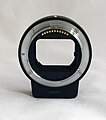Nikon Z 7
| Nikon Z 7 | |

|
|
| Type: | Mirrorless system camera |
| Lens connection : | Nikon Z bayonet |
| Image sensor : | CMOS |
| Sensor size: | 35.9 mm x 23.9 mm |
| Resolution : | 45.7 megapixels |
| Image size: | 8256 × 5504 (FX, 36 × 24) |
| Format factor : | 1 in FX format |
| File formats : | RAW / NEF (12 or 14 bit), TIFF , JPEG |
| Exposure index : | 64-25,600 (expandable to 102,400) |
| Viewfinder : | 1.27 cm OLED viewfinder monitor with approximately 3.69 million pixels |
| Field of view : | 100% |
| Enlargement: | 0.8 × |
| Screen : | TFT-LCD, tiltable |
| Size: | 8.1 cm (3.2 ″) |
| Operating modes: | manually (M), aperture priority mode (A), auto iris (S), automatic program (P) |
| Frame rate : | 9 fps |
| AF points: | 493 measuring fields |
| AF measuring range: | −1 to +19 EV |
| AF modes: | Individual field control, dynamic measuring field control (9, 25, 72 or 153 measuring fields), 3D tracking, measuring field group control, automatic measuring field control |
| Exposure metering : | TTL exposure metering |
| Measuring range: | -3 to 17 EV (matrix or center-weighted metering) |
| Correction : | ± 5 EV |
| Closure : | electronically controlled, vertical focal plane shutter |
| Shutter speed : | 1 / 8,000 s to 30 s, bulb long exposure |
| Lightning : | only external |
| Flash control: | i-TTL automatic flash |
| Lightning connection : | Hot shoe, ISO 518 |
| Synchronization : | 1/200 s |
| Exposure compensation : | -3 to +1 EV |
| Storage media : | 1 × XQD / CFexpress |
| Data interface : | USB 3.0, HDMI |
| Power supply: | Nikon EN-EL15b or EN-EL15a / EN-EL15 lithium-ion battery, mains adapter EH-5c / EH-5b Battery compartment insert EP-5B (accessory) |
| Dimensions: | 100.5 mm × 134 mm × 67.5 mm |
| Weight: | 585 g (camera housing only), 675 g (with battery and memory card, but without housing cover) |
| Additions: | Image sensor cleaning |
The Nikon Z 7 is a mirrorless system camera housing from the Japanese manufacturer Nikon with a Z bayonet . The camera was presented on August 23, 2018 and is designed for professional use.
technical features
With the Z 6 and Z 7 models, the Z series initially comprises two mirrorless system camera housings with full-format sensors . Both cameras use a back-illuminated chip (Back Side Illumination, BSI technology) without a low-pass filter . The filter glass of the image sensor of the Z 7 has a better anti-reflective coating, so that unwanted reflections between the image sensor and objective lenses are more strongly suppressed. The inside diameter of the Nikon Z bayonet is 55 millimeters and at the time of the announcement it was the full-frame bayonet with the largest inside diameter. The larger opening means that more light can be directed onto the image sensor through the new Z lenses. A corresponding, manually focussed 0.95 / 58 mm lens was announced for 2019, which is extremely bright .
The Z 7 has 493 focus areas , which is significantly more than previous Nikon cameras. A five-axis image stabilizer (VR) is integrated into the weatherproof camera housing and it has extensive video functions.
At the same time as the Z 6 and Z 7 camera models, Nikon initially presented three new lenses for the Z-mount: a 35mm f / 1.8, a 50mm f / 1.8 and a zoom 24–70mm f / 4. The new Z-Mount is the first new development of a lens connection for 35mm cameras from Nikon since 1959, so there is a wide range of high-performance lenses from many manufacturers for the F-Mount. In order to ensure that these lenses can be used seamlessly, Nikon has provided the Z models with an F- to Z-mount adapter with which, with a few exceptions, all Nikon F lenses since 1959 can be connected to the Z series cameras can. Modern AF-S, AF-P and AF-I Nikkor lenses can be used with this adapter on the Z 7 without restrictions. Older AF-D Nikkor lenses without their own AF motor can use all other functions except for the autofocus, such as B. Focus peaking in the viewfinder, VR, exposure control and all exposure modes. Even older AF (without D-Chip), AI or AI-S Nikkor lenses no longer allow focus peaking and the number of exposure modes that can be used may also be limited.
production
The Z 7 is manufactured at the Nikon factory in Sendai , Japan . According to Nikon's plans, 20,000 Z 6 and Z 7 are to be produced there every month.
Awards
The Photo Press Association Technical Image Press Association (TIPA) honored the Z 7 model as the best camera with full-frame sensor for professionals with the TIPA World Award 2019 .
literature
- Heike Jasper: Nikon Z7. The manual for the camera. Rheinwerk, Bonn 2019, ISBN 978-3-8362-6845-5 . (With glossary and index)
Web links
Individual evidence
- ↑ Presentation of the Nikon Z6 and Z7
- ↑ Digital cameras in the test / New highlights for beginners and professionals / Nikon Z6 , test.de from January 25, 2019, accessed on February 12, 2019
- ↑ Z 7 , nikon.de, accessed on August 25, 2018
- ↑ Compatibility FTZ adapter , FTZ at Kenrockwell
- ↑ Andreas Jordan: This is where the Nikon Z6 and Z7 are manufactured: A look behind the scenes of the factory in Sendai. In: Photo magazine. September 14, 2018, accessed October 27, 2019 .
- ↑ TIPA World Award 2019





